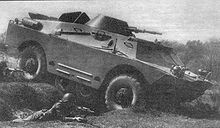BRDM-2
The BRDM-2 (Boyevaya Razvedyvatelnaya Dozornaya Mashina, Боевая Разведывательная Дозорная Машина, literally "Combat Reconnaissance/Patrol Vehicle")[5] is an amphibious armoured scout car designed and developed in the Soviet Union.
The vehicle had no turret and to operate the armament the gunner had to open a hatch and expose himself to enemy fire.
The vehicle was not fitted with an NBC protection system, and had no night vision equipment by default.
These drawbacks encouraged the design team to create a new vehicle which would suit the modern battlefield.
When the shutters are in their opened position, they protect the driver and commander from being blinded by the sunlight and ensure that the windscreen won't be blurred by rain or snow.
The GAZ-41 gasoline V-8 engine supplies power to the circular water-jet, equipped with a four-bladed propeller at the rear of the vehicle, which is covered with an armoured shutter while on land.
The armament is the same as the BTR-60PB armoured personnel carrier; a 14.5 mm KPVT heavy machine gun with a coaxial 7.62 mm PKT general-purpose machine gun as a secondary weapon, both in a small conical BPU-1 turret mounted on the hull in a central position above the belly wheels.
The vehicle armor, which is composed of welded steel, is sufficient against small arms fire and small shell fragments; but not enough for protection against big artillery fragments or .50-calibre machine gun fire, which can penetrate the BRDM-2's maximum armor of 14 mm.
These include the poor ergonomic design, low level of crew protection and high fuel consumption.
[1] The BRDM-2 is sometimes confused with the Hungarian D-442 FUG and D-944 PSzH amphibious scout cars, which also have rear-mounted engines.
The BRDM-2 became famous for being the vehicle selected to pull the Soviet leader Leonid Brezhnev's coffin during the funeral ceremony in the Red Square.
[8] Poland bought 450 BRDM-2 armoured scout cars, 418 9P133 "Malyutka" and 9P148 "Konkurs" tank destroyers and 32 BRDM-2RS NBC reconnaissance vehicles in 1965.
Currently, the Polish Army operates 200 BRDM-2s, 120 BRDM-2s modernized to BRDM-2M-96, BRDM-2M-96i, BRDM-2M-97 "Żbik-B" and BRDM-2M-98 "Żbik-A" level, 12 BRDM-2s modernized to BRDM-2M-96ik "Szakal" level, 100 9P133 "Malyutka" and 18 9P148 "Konkurs" tank destroyers, 12 BRDM-2RS NBC reconnaissance vehicles, an unknown number of 9K31 Strela-1 self-propelled surface-to-air missile launchers as well as BRDM-2 R-1A and BRDM-2 R-5 command vehicles.
Modernized BRDM-2 armoured scout cars will serve with the Polish Army for at least a couple of years.
The 9P133 "Malyutka" and 9P148 "Konkurs" tank destroyers, which are the basic equipment of anti-tank subunits of motorized brigades, are considered obsolete and therefore are to be replaced with ATGM launchers based on lighter vehicles, like the HMMWV, or heavier vehicles like the KTO Ryś APC or KTO Rosomak AMV.
[1] For MSPO 2002, two Polish BRDM-2M-96i were converted into a fire unit and command vehicle with a radar of the German Rheinmetall Defence Electronics ASRAD-R missile air defense system.
Seven BRDM-2M-97 "Żbik-B" armoured scout cars and six 9P148 "Konkurs" tank destroyers took part in a military parade in Warsaw on the Polish Army Day, 15 August 2008.
Polish KFOR units also use BRDM-2M-96 armoured scout cars and BRDM-2RS NBC reconnaissance vehicles.
On the morning of 13 June 2014, during the First Battle of Mariupol, the Azov Battalion, Dnipro-1 Battalion and the National Guard of Ukraine retook the city and key buildings occupied by insurrectionists killing five militants and destroying an insurrectionist BRDM-2 armoured vehicle.
As of February 5th 2025 the open source intelligence website Oryx reports 17 BDRM-2s lost on the Russian side, and 157 for the Ukrainians.
[14][15] Syria received hundreds of BRDM-2, as well as specialized variants, BRDM-2 RKh (radiological-chemical recce), 9P122, 9P148 (both anti-tank missile carriers) and 9K31 Strela-1 (SAM version).
The Syrian Armed Forces used the BRDM-2s for security patrols during the Lebanon Civil War, the light vehicles proving themselves very suitable for this type of operation.
[citation needed] At the beginning of the 2010s, the BRDM-2s, thought to be unsuitable to modern combat against Israeli forces, were retired from service.
[citation needed] The Soviet Union began supplying the People's Armed Forces for the Liberation of Angola (FAPLA) with BRDM-2s shortly after Angolan independence.
At least one fell victim to a rebel Panhard AML-90 crewed by South African advisers during Operation Savannah.
BRDM-2 armoured scout cars are used by Polish, Ukrainian[17] and Russian units of the Kosovo Force.




























